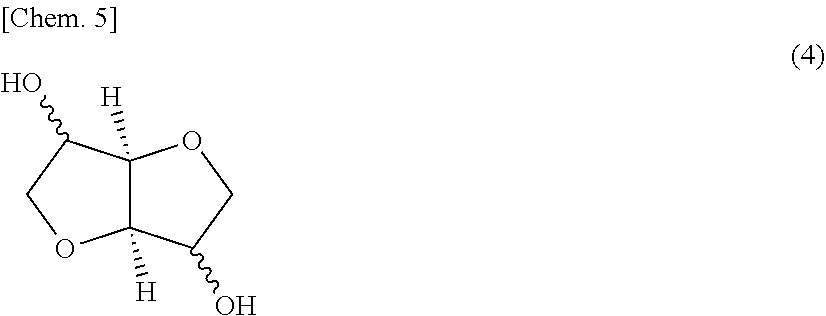Polycarbonate resin composition and molded article
- Summary
- Abstract
- Description
- Claims
- Application Information
AI Technical Summary
Benefits of technology
Problems solved by technology
Method used
Image
Examples
example 1
[0185]ISB, CHDM, DPC which had been purified by distillation to reduce the chloride ion concentration thereof to 10 ppb or less, and calcium acetate monohydrate were introduced in an ISB / CHDM / DPC / calcium acetate monohydrate molar ratio of 0.70 / 0.30 / 1.00 / 1.3×10−6 into a polymerizer equipped with a stirrer and a reflux condenser regulated to 100° C. Nitrogen displacement was sufficiently conducted (oxygen concentration, 0.0005-0.001% by volume). Subsequently, the contents were heated with a heat medium, and stirring was initiated at the time when the internal temperature reached 100° C. The contents were melted and homogenized while regulating the internal temperature to 100° C. Thereafter, heating was initiated, and the internal temperature was elevated to 210° C. over 40 minutes. At the time when the internal temperature reached 210° C., the polymerizer was regulated so as to maintain this temperature and pressure reduction was initiated simultaneously. The internal pressure was red...
example 2
[0192]A polycarbonate resin composition was obtained in the same manner as in Example 1, except that the molar ratio between ISB and CHDM in Example 1 was changed as shown in Table 1 and that the light resistance improver used in Example 1 was omitted. The polycarbonate resin composition obtained was analyzed and evaluated in the same manners as in Example 1, and the results thereof are shown in Table 1.
example 3
[0193]A polycarbonate resin composition was obtained in the same manner as in Example 1, except that the molar ratio between ISB and CHDM in Example 1 was changed as shown in Table 1. The polycarbonate resin composition obtained was analyzed and evaluated in the same manners as in Example 1, and the results thereof are shown in Table 1.
PUM
| Property | Measurement | Unit |
|---|---|---|
| Temperature | aaaaa | aaaaa |
| Fraction | aaaaa | aaaaa |
| Percent by mass | aaaaa | aaaaa |
Abstract
Description
Claims
Application Information
 Login to View More
Login to View More - R&D
- Intellectual Property
- Life Sciences
- Materials
- Tech Scout
- Unparalleled Data Quality
- Higher Quality Content
- 60% Fewer Hallucinations
Browse by: Latest US Patents, China's latest patents, Technical Efficacy Thesaurus, Application Domain, Technology Topic, Popular Technical Reports.
© 2025 PatSnap. All rights reserved.Legal|Privacy policy|Modern Slavery Act Transparency Statement|Sitemap|About US| Contact US: help@patsnap.com



